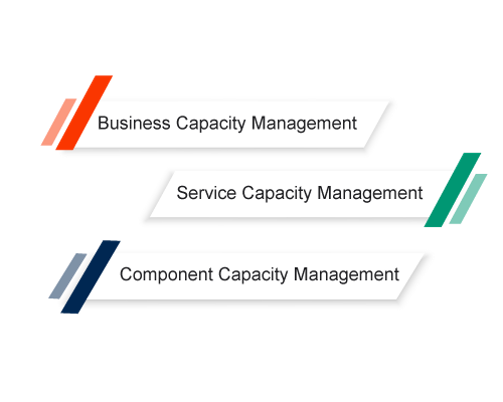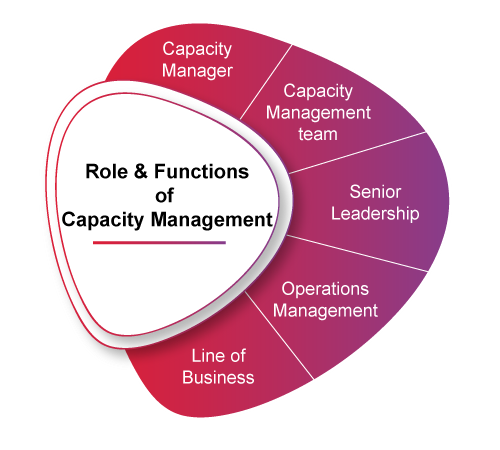
By ensuring effective capacity management in an organization can be really efficient in terms of productivity, revenue, etc. Any organization gets their merit with their capabilities and the readiness of the resources that brings the product/deliverables to its conclusion. In this article, we will learn about “what is capacity management”, the objective of capacity management, the basic principles of capacity management, and the various processes of capacity management.
What is Capacity Management?
The capacity of an organization shows its ability to do work. Capacity management is the process that is used to ensure that the IT capacity is capable of continual provision of consistent and acceptable service levels at a known and controlled cost.
Purpose of Capacity Management
The main purpose is to make sure that the capacity of the IT services and infrastructure is able to meet the agreed-upon requirements of capacity and performance in a manner that is both timely and cost-effective.
Objectives of Capacity Management
The objectives are as follows:
- Identify the requirements of IT capacity in order to meet the present and future workloads
- Generate and maintain a capacity plan which is accurate
- Provide guidance and advice on all issues related to capacity and performance.
- Make sure that the service performance achievements meet their agreed-upon targets
- Measure and monitor capacity to support the service level management.
- Provide assistance with the diagnosis and resolution of incidents and problems.
- Analyze the impact which the changes have had on the capacity plan and take proactive measures to improve the performance wherever it is cost-effective.
Scope of Capacity Management
Capacity management is a process that extends across the entire service lifecycle. It is a focal point for all the issues related to IT performance and capacity in an organization. Different technical domains may carry out a majority of the day-to-day duties, but capacity management still has the overall responsibility.
The capacity management process should cover the operational and development environment which includes the hardware, networking equipment, peripherals, software, and human resources. Capacity management makes sure that the IT resources are planned and scheduled to deliver a level of service which is consistent and matched to the present and future needs of the business.
Value of Capacity Management
Capacity management provides several benefits to the business. Some of them are:
- Improvement in performance and availability of IT services.
- Distinguishing the activities which are long-term and strategic from the ones which are day-to-day operational tasks.
- Reduction in problems and incidents related to capacity and performance.
- Focusing the awareness on proactive considerations while dealing with capacity matters.
- Making sure that the required capacity and performance are provided in a manner that is very cost-effective.
- Using a forward-looking capacity plan to improve the reliability of capacity-related budgeting.
Principles and Basic Concepts of Capacity Management
Capacity management is mainly about the management of relationships between the 3 variables – resources, workload, and service levels, which are interconnected. It is a balancing act involving:
- Balancing the costs incurred against the resources required
- Balancing the supply against demand
Capacity management relies on three sub-processes to deliver results as it is a complex and demanding process. They are:
Business Capacity Management
-
- It translates business needs and plans into requirements for IT services and infrastructure.
- It is the driving force for the whole process.
- The updates to the business plans encapsulate the long-term strategy of an organization.
Service Capacity Management
-
- Capacity management should understand the resources, working patterns, peaks, and lows of the IT services. By doing so, they can contribute to the service by meeting its service level agreement targets.
- Service capacity management predicts, manages, and controls the end-to-end performance of the operational IT services and their workloads.
- The main focus is on managing the performance of the service as it is determined by targets contained within the service level agreements or requirements.
Component Capacity Management
-
- It involves foreseeing, handling, and governing the performance, utilization, and capacity of individual IT components.
- Every hardware component and many software in the IT infrastructure have a definite capacity that can be measured, and when it is exceeded, can lead to performance-related issues and other problems.

Capacity Management Process
The primary activities of the whole process are carried out both proactively and reactively. Usually, there is more emphasis placed on proactive capacity management as a lesser amount of effort is required to react to incidents and problems which occur because of issues related to capacity or performance.
The proactive activities of capacity management consist of the following:
- Pre-empting the issues related to the performance by implementing the corrective actions before the problems can arise.
- Generating trends about the present level of utilization and estimating the requirements of the future.
- Making models and trends based on the changes which are predicted in the IT services.
- Making sure that all the upgrades are budgeted, planned, and implemented on time.
- Creating capacity plans and maintaining them.
- Optimizing the performance of the services and the components to increase their efficiency.
The reactive activities of capacity management consist of the following:
- Keeping tabs on, measuring, reporting, and reviewing the present performance of the business.
- Responding to events that are related to the capacity-related threshold and making sure that corrective measures are applied.
Roles and Functions
- Capacity Manager
- Owns the entire process.
- Makes sure that the right procedures are followed.
- Represents the interests of the process at various meetings and functions.
- Does verification and makes adjustments for the various parameters used in the planning process.
- Makes recommendations to re-allocate the resources.
- Team
- Is in charge of generating a capacity plan which is planned to take into account the changes in IT capacity of the future.
- Does the documentation if there is a need for upgrading the hardware, software, resources, or additional equipment on the basis of the service level requirements, budgetary constraints, and availability.
- Generates regular reports on the present usage of resources and the forecasted trends for future usage.
- Is responsible for documenting the managing process.
- Senior Leadership
- Approve the resources which are required to meet the capacity.
- Review the present capacity and give recommendations to improve the capacity.
- Performs the role of the final escalation point for any issues which arise.
- Operations Management
- Provides assistance in describing the service chains which are associated with service provisioning.
- Participates in various discussions related to capacity.
- Helps to meet the operational level Objectives.
- Lines of Business
- They negotiate the capacity targets and authorize targets in operational level agreements and service level agreements
- Provide whatever information is required on capacity.
- Review the performance of the capacity against the intended target and take part in the preparation and recommendation of remedial solutions.
Risks & Challenges
The challenges faced are as follows:
- Making sure that accurate business plans are provided for basing the capacity plan.
- Collecting and combining a large amount of data that is available in a way that is supportive of the process.
Risks of Capacity Management
The risks that we face are as follows:
- A lack of commitment shown by the business to the process of capacity management.
- A lack of commitment from the senior management.
- The absence of an adequate amount of resources and budget.
- Bureaucratic or manually intensive processes.
- Service and component capacity management performed in isolation since the management of business capacity is difficult.
Conclusion
This process in an organization identifies the requirements of IT capacity while generating and maintaining accurate plans. It can hence provide guidance and take proactive measures to improve performance wherever it is cost-effective. Give yourself a chance to grow in your Service Management career with the ITIL 4 Foundation certification training, and gain useful skills and best practices.
Know more about Service Management best practices through Invensis Learning’s IT Service Management certification training on ITIL 4 Foundation Online Course, SIAM Foundation, SIAM professional, VeriSM, etc.

















